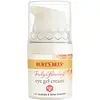What's inside
What's inside
 Key Ingredients
Key Ingredients

 Benefits
Benefits

 Concerns
Concerns

 Ingredients Side-by-side
Ingredients Side-by-side

Water
Skin ConditioningGlycerin
HumectantMango Butter Dimer Dilinoleyl Esters/Dimer Dilinoleate Copolymer
EmollientBentonite
AbsorbentCaprylic/Capric Triglyceride
MaskingUndecane
EmollientC10-18 Triglycerides
EmollientBeeswax
Emulsion StabilisingInulin
Skin ConditioningSqualane
EmollientCandelilla/Jojoba/Rice Bran Polyglyceryl-3 Esters
EmulsifyingGlyceryl Stearate
EmollientTridecane
PerfumingCarthamus Tinctorius Seed Oil
MaskingSimmondsia Chinensis Seed Oil
EmollientHydrolyzed Hyaluronic Acid
HumectantCetearyl Alcohol
EmollientSodium Stearoyl Lactylate
EmulsifyingSilica
AbrasiveTocopherol
AntioxidantSodium PCA
HumectantXanthan Gum
EmulsifyingParfum
MaskingCitric Acid
BufferingPotassium Sorbate
PreservativeLecithin
EmollientSclerotium Gum
Emulsion StabilisingSodium Phytate
Pullulan
Alcohol
AntimicrobialPhenoxyethanol
PreservativeEthyl Lauroyl Arginate Hcl
Skin ConditioningWater, Glycerin, Mango Butter Dimer Dilinoleyl Esters/Dimer Dilinoleate Copolymer, Bentonite, Caprylic/Capric Triglyceride, Undecane, C10-18 Triglycerides, Beeswax, Inulin, Squalane, Candelilla/Jojoba/Rice Bran Polyglyceryl-3 Esters, Glyceryl Stearate, Tridecane, Carthamus Tinctorius Seed Oil, Simmondsia Chinensis Seed Oil, Hydrolyzed Hyaluronic Acid, Cetearyl Alcohol, Sodium Stearoyl Lactylate, Silica, Tocopherol, Sodium PCA, Xanthan Gum, Parfum, Citric Acid, Potassium Sorbate, Lecithin, Sclerotium Gum, Sodium Phytate, Pullulan, Alcohol, Phenoxyethanol, Ethyl Lauroyl Arginate Hcl
Water
Skin ConditioningDipropylene Glycol
HumectantButylene Glycol
Humectant1,2-Hexanediol
Skin ConditioningGlycerin
HumectantCetearyl Olivate
Sorbitan Isostearate
EmulsifyingHydroxyethyl Acrylate/Sodium Acryloyldimethyl Taurate Copolymer
Emulsion StabilisingCarbomer
Emulsion StabilisingPvm/Ma Copolymer
Emulsion StabilisingSorbitan Olivate
EmulsifyingCeramide NP
Skin ConditioningCholesterol
EmollientPhytosphingosine
Skin ConditioningPolyglyceryl-10 Myristate
Skin ConditioningSodium Hyaluronate
HumectantStearic Acid
CleansingHydrolyzed Hyaluronic Acid
HumectantOleic Acid
EmollientCaprylic/Capric Triglyceride
MaskingSodium Acetylated Hyaluronate
HumectantEthylhexylglycerin
Skin Conditioning3-O-Ethyl Ascorbic Acid
Skin ConditioningTocopherol
AntioxidantGlyceryl Acrylate/Acrylic Acid Copolymer
HumectantHydrogenated Lecithin
EmulsifyingMenthyl Lactate
MaskingEthyl Menthane Carboxamide
TonicMethyl Diisopropyl Propionamide
MaskingSodium Phytate
Caprylhydroxamic Acid
Lactic Acid
BufferingTromethamine
BufferingCaprylyl Glycol
EmollientWater, Dipropylene Glycol, Butylene Glycol, 1,2-Hexanediol, Glycerin, Cetearyl Olivate, Sorbitan Isostearate, Hydroxyethyl Acrylate/Sodium Acryloyldimethyl Taurate Copolymer, Carbomer, Pvm/Ma Copolymer, Sorbitan Olivate, Ceramide NP, Cholesterol, Phytosphingosine, Polyglyceryl-10 Myristate, Sodium Hyaluronate, Stearic Acid, Hydrolyzed Hyaluronic Acid, Oleic Acid, Caprylic/Capric Triglyceride, Sodium Acetylated Hyaluronate, Ethylhexylglycerin, 3-O-Ethyl Ascorbic Acid, Tocopherol, Glyceryl Acrylate/Acrylic Acid Copolymer, Hydrogenated Lecithin, Menthyl Lactate, Ethyl Menthane Carboxamide, Methyl Diisopropyl Propionamide, Sodium Phytate, Caprylhydroxamic Acid, Lactic Acid, Tromethamine, Caprylyl Glycol
 Reviews
Reviews

Ingredients Explained
These ingredients are found in both products.
Ingredients higher up in an ingredient list are typically present in a larger amount.
This ingredient is an emollient, solvent, and texture enhancer. It is considered a skin-softener by helping the skin prevent moisture loss.
It helps thicken a product's formula and makes it easier to spread by dissolving clumping compounds.
Caprylic Triglyceride is made by combining glycerin with coconut oil, forming a clear liquid.
While there is an assumption Caprylic Triglyceride can clog pores due to it being derived from coconut oil, there is no research supporting this.
Learn more about Caprylic/Capric TriglycerideGlycerin is already naturally found in your skin. It helps moisturize and protect your skin.
A study from 2016 found glycerin to be more effective as a humectant than AHAs and hyaluronic acid.
As a humectant, it helps the skin stay hydrated by pulling moisture to your skin. The low molecular weight of glycerin allows it to pull moisture into the deeper layers of your skin.
Hydrated skin improves your skin barrier; Your skin barrier helps protect against irritants and bacteria.
Glycerin has also been found to have antimicrobial and antiviral properties. Due to these properties, glycerin is often used in wound and burn treatments.
In cosmetics, glycerin is usually derived from plants such as soybean or palm. However, it can also be sourced from animals, such as tallow or animal fat.
This ingredient is organic, colorless, odorless, and non-toxic.
Glycerin is the name for this ingredient in American English. British English uses Glycerol/Glycerine.
Learn more about GlycerinHydrolyzed Hyaluronic Acid is a form of hyaluronic acid. It is created by the hydrolysis of hyaluronic acid with a high molecular weight. Once created, Hydrolyzed Hyaluronic Acid has a low molecular weight.
Low molecular weight HA has been shown to hydrate and increase elasticity of the skin. Increasing elasticity is also associated with reduction of wrinkle depth.
One study found topical low molecular weight hyaluronic acid may be considered for the treatment of rosacea in the adult population. However, we always recommend speaking with a professional about your skin concerns.
Hyaluronic acids are a humectant. This means they draw moisture from the air. Hyaluronic acids help moisturize, soothe, and protect the skin.
Read more about other common forms of hyaluronic acid:
Learn more about Hydrolyzed Hyaluronic AcidSodium Phytate is the synthetic salt form of phytic acid. Phytic acid is an antioxidant and can be found in plant seeds.
Sodium Phytate is a chelating agent. Chelating agents help prevent metals from binding to water. This helps stabilize the ingredients and the product.
Tocopherol (also known as Vitamin E) is a common antioxidant used to help protect the skin from free-radicals and strengthen the skin barrier. It's also fat soluble - this means our skin is great at absorbing it.
Vitamin E also helps keep your natural skin lipids healthy. Your lipid skin barrier naturally consists of lipids, ceramides, and fatty acids. Vitamin E offers extra protection for your skin’s lipid barrier, keeping your skin healthy and nourished.
Another benefit is a bit of UV protection. Vitamin E helps reduce the damage caused by UVB rays. (It should not replace your sunscreen). Combining it with Vitamin C can decrease sunburned cells and hyperpigmentation after UV exposure.
You might have noticed Vitamin E + C often paired together. This is because it is great at stabilizing Vitamin C. Using the two together helps increase the effectiveness of both ingredients.
There are often claims that Vitamin E can reduce/prevent scarring, but these claims haven't been confirmed by scientific research.
Learn more about TocopherolWater. It's the most common cosmetic ingredient of all. You'll usually see it at the top of ingredient lists, meaning that it makes up the largest part of the product.
So why is it so popular? Water most often acts as a solvent - this means that it helps dissolve other ingredients into the formulation.
You'll also recognize water as that liquid we all need to stay alive. If you see this, drink a glass of water. Stay hydrated!
Learn more about Water